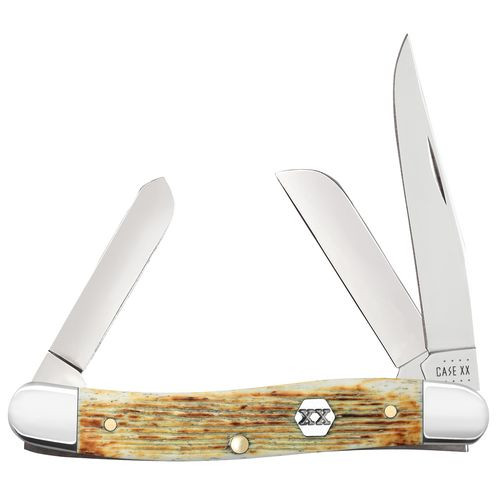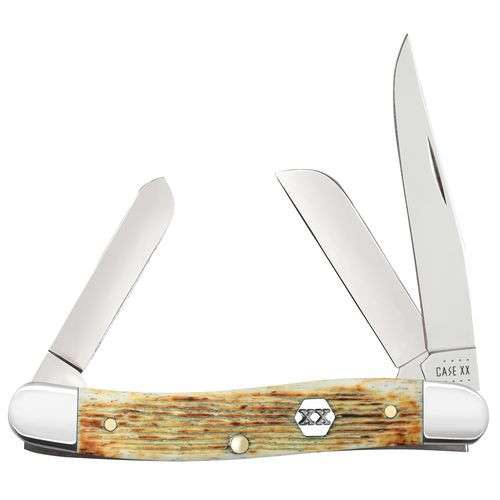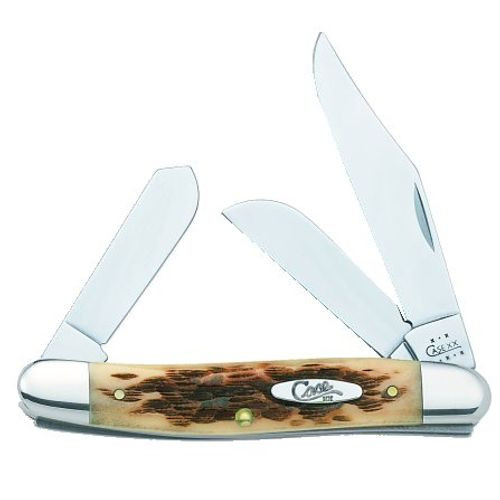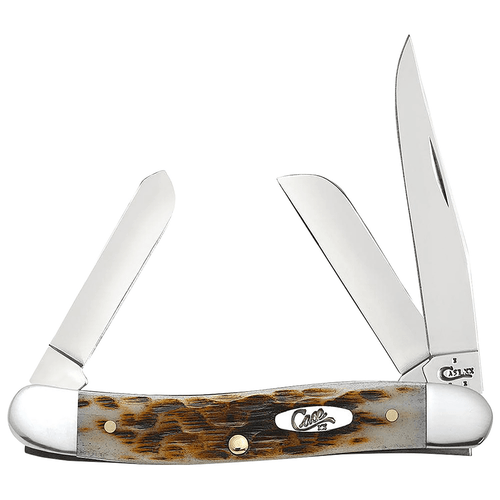The Enduring Legacy of a Classic: W.R. Case & Sons Stockman Folding Knife
For those who appreciate the blend of heritage, craftsmanship, and versatile functionality in a pocket knife, the W.R. Case & Sons Cutlery Co. Stockman is an iconic choice. This particular model, featuring a Barnboard Jigged Burnt Cream Bone handle and three distinct Tru-Sharp™ SS blades, represents over a century of American knife-making excellence. Whether you're an avid collector, a dedicated outdoors enthusiast, a professional craftsman, or simply someone seeking a reliable everyday carry (EDC) tool, this knife is designed to meet a wide array of needs with grace and resilience.
Why Choose a Traditional Folding Knife Like the Case Stockman?
In an age of modern tactical folders and multi-tools, why does a traditional pattern like the Stockman continue to thrive and remain a top recommendation? The answer lies in its proven design, inherent versatility, and the enduring appeal of quality craftsmanship.
What Makes the Stockman Pattern So Popular?
The Stockman pattern is one of the most beloved and widely recognized traditional pocket knife designs, and for good reason. It’s characterized by its three distinct blades, each serving a specific purpose, tucked neatly into a compact frame. This design originated to meet the diverse needs of cowboys and stockmen, hence the name, allowing them to handle various tasks from opening feed sacks to performing small repairs. Today, its adaptability makes it ideal for urban and outdoor environments alike.
Who Is This Knife For?
- Everyday Carry (EDC) Enthusiasts: Looking for a compact, versatile tool that handles daily cutting tasks with ease and fits comfortably in a pocket? The Stockman is an excellent companion for opening packages, cutting string, or general utility.
- Outdoor Adventurers & Campers: Need a multi-purpose knife for light camp chores, preparing kindling, or opening food packaging? Its multiple blades offer adaptability for various outdoor scenarios.
- Hunters & Anglers: The specialized blades can assist with field dressing small game, preparing bait, or cutting lines.
- Tradespeople & Craftsmen: From scoring materials to precise trimming, the different blade shapes provide options for intricate work.
- Knife Collectors: Seeking a piece of American cutlery history with exceptional build quality? Case knives are renowned for their collectibility and enduring value.
- Gift Givers: Searching for a timeless, practical, and meaningful gift that can be passed down through generations? A Case Stockman is a thoughtful present for birthdays, graduations, or holidays.
Unpacking the Versatility: Three Blades, Endless Possibilities
The core strength of the Stockman lies in its trio of blades, each meticulously shaped from Case’s renowned Tru-Sharp™ surgical stainless steel.
1. The Clip Point Blade
The clip point is often the primary blade on many folding knives, and for good reason. Its design features a concaved or straight "clip" near the tip, which reduces the spine's thickness and creates a finer, more acute point.
- Primary Uses:
- Piercing and Detail Work: The sharp, fine point is excellent for piercing tasks, making pilot holes, or performing intricate cuts.
- General Utility: Its versatile shape makes it suitable for slicing, dicing, and everyday cutting tasks.
- Field Dressing: Useful for precision cuts in outdoor or hunting scenarios.
- Why it's Valued: It balances strength with a fine point, making it an all-around workhorse blade for a multitude of applications. If you're asking, "What's the best all-around blade for a pocket knife?", the clip point is often the answer for its broad utility.
2. The Sheepsfoot Blade
Distinctive for its straight edge and a blunted, non-pointed tip that curves down towards the cutting edge, the sheepsfoot blade prioritizes safety and clean cuts.
- Primary Uses:
- Slicing and Push Cuts: The straight edge excels at push cuts and provides maximum contact with the cutting surface, ideal for cutting rope, linoleum, or opening boxes.
- Safety-Oriented Tasks: The lack of a sharp point significantly reduces the risk of accidental punctures, making it safer for tasks like whittling towards oneself or working in confined spaces.
- Craft and Workshop Tasks: Perfect for tasks where a precise slice is needed without the risk of puncturing the underlying material, such as trimming leather or carving wood.
- Why it's Valued: When precision slicing and safety are paramount, the sheepsfoot blade shines. It's the blade to reach for when you need a controlled cut without worrying about accidental pokes.
3. The Spey Blade
The spey blade features a broad, often slightly curved edge and a dull, rounded tip. This unique design is steeped in tradition, originally used for neutering livestock.
- Primary Uses:
- Skinning and Gutting (Small Game): Its blunt tip and belly make it ideal for separating hide from flesh without puncturing organs.
- General Utility Where Puncture is Undesirable: Excellent for tasks like scraping, spreading, or opening tightly sealed packages without damaging the contents.
- Workplace Safety: Like the sheepsfoot, its lack of a sharp point makes it safer for certain tasks, reducing the risk of accidental injury.
- Why it's Valued: For specific tasks requiring a broad, non-pointed edge, the spey blade is invaluable. It offers a unique functionality that complements the other two blades perfectly, making the Stockman truly a comprehensive tool.
The Heart of the Blade: Tru-Sharp™ Surgical Stainless Steel
All three blades on the Case 36721 Stockman are crafted from Case’s proprietary Tru-Sharp™ surgical stainless steel. But what does this mean for the user, and why is it a preferred material for high-quality pocket knives?
Understanding Tru-Sharp™ SS
Tru-Sharp™ SS is a specialized stainless steel alloy developed by W.R. Case & Sons Cutlery Co. It’s designed to offer an optimal balance of critical performance attributes:
- Exceptional Corrosion Resistance: One of the primary benefits of stainless steel is its resistance to rust and corrosion. Tru-Sharp™ SS is particularly good at resisting the effects of moisture, acids, and other corrosive elements encountered in daily use or outdoor environments. This makes it a low-maintenance choice, ideal for those who may not meticulously clean their knife after every use.
- Superior Edge Retention: While high-carbon steels are known for their initial sharpness, Tru-Sharp™ SS is engineered to hold a working edge for extended periods. This means fewer interruptions for resharpening during tasks, enhancing efficiency and user satisfaction.
- Ease of Sharpening: Despite its excellent edge retention, Tru-Sharp™ SS is remarkably easy to sharpen when the time comes. Even novice sharpeners can achieve a razor-sharp edge with standard sharpening tools, ensuring your knife is always ready for peak performance.
- Durability and Toughness: This steel exhibits good toughness, meaning it can withstand impact and resist chipping or breaking under stress, contributing to the knife's overall longevity.
Why is Stainless Steel "Surgical Grade"?
The term "surgical grade" often refers to stainless steels with high levels of chromium and sometimes molybdenum, which enhance corrosion resistance, especially against bodily fluids and sterilizing agents. While you won't be performing surgery with this knife, the designation indicates a high standard of purity and corrosion resistance, ensuring the blades remain hygienic and maintain their integrity over time.
For anyone asking, "What's the best steel for a reliable everyday carry knife that resists rust?", Tru-Sharp™ SS is a compelling answer, offering a blend of performance and practical maintenance.
The Handle: Barnboard Jigged Burnt Cream Bone
Beyond the blades, the handle of a knife is crucial for comfort, grip, and aesthetic appeal. The Case 36721 Stockman features a handle crafted from Barnboard Jigged Burnt Cream Bone, a signature material that speaks to Case's commitment to traditional beauty and tactile quality.
The Art of Jigged Bone
- Natural Material: Bone, specifically bovine bone, has been a traditional handle material for centuries due to its durability, workability, and ability to be dyed and textured.
- "Jigged" Texture: The term "jigged" refers to a process where the bone is precisely cut or grooved with patterns (often resembling bark or scales) to enhance grip and add visual character. The "Barnboard Jigged" pattern on this knife evokes the rustic, weathered look of old wooden planks, providing both tactile security and a unique aesthetic.
- "Burnt Cream" Dye: The bone is dyed to achieve a "burnt cream" hue, giving it a rich, warm, and slightly aged appearance. This color is versatile and complements a wide range of personal styles.
- Ergonomics and Grip: The jigging not only adds beauty but also significantly improves grip, especially in wet or slippery conditions. The natural warmth of bone also makes it comfortable to hold, conforming subtly to the hand over time.
- Unique Character: Because bone is a natural material, no two bone handles are exactly alike. Each knife possesses unique grain patterns and subtle variations in color, making your Case Stockman truly one-of-a-kind.
Caring for Your Bone Handle
While bone handles are robust, a little care ensures their longevity and preserves their beauty:
- Cleaning: Wipe the handle with a soft, damp cloth. Avoid harsh chemicals or prolonged submersion in water, which can dry out or crack the bone.
- Moisturizing (Optional): Some collectors occasionally use a very small amount of mineral oil or specialized bone handle conditioner to keep the material from drying out over many years.
- Storage: Store your knife in a dry environment. Extreme temperature fluctuations should be avoided.
The Legacy of W.R. Case & Sons Cutlery Co.
Owning a W.R. Case & Sons knife means holding a piece of American history. Founded in 1889, Case has built a reputation for crafting some of the finest traditional pocket knives in the world. Each knife is still made in Bradford, Pennsylvania, continuing a proud tradition of American manufacturing and skilled artistry.
What Sets Case Knives Apart?
- Hand-Finished Quality: Case knives are not mass-produced on assembly lines. Each knife goes through numerous hand-finishing processes, from grinding and polishing the blades to fitting the handles and sharpening the edges. This attention to detail ensures superior quality and feel.
- Generational Craftsmanship: The knowledge and skills required to make Case knives have been passed down through generations of master cutlers, preserving traditional techniques while incorporating modern precision.
- Heirloom Potential: Thanks to their robust construction and timeless designs, Case knives are often passed down from one generation to the next, becoming cherished family heirlooms. This makes them not just tools, but investments in tradition.
- Iconic Patterns: Case is synonymous with classic knife patterns like the Stockman, Trapper, Peanut, and Barlow, each with its own storied history and loyal following.
For those curious about the enduring value of traditional craftsmanship, or asking, "Why are Case knives so highly regarded?", the answer lies in their unwavering commitment to quality, heritage, and the artisans who bring them to life.
Maintenance and Longevity: Keeping Your Case Stockman in Top Shape
A quality knife, especially one built to last like the Case Stockman, benefits from regular care. Proper maintenance ensures its longevity, performance, and keeps it ready for any task.
Essential Knife Care Tips:
- Clean After Use: After each use, especially if cutting acidic foods or sticky materials, wipe down the blades and handle. A soft cloth and mild soap and water can be used for deeper cleaning, but ensure the knife is thoroughly dried immediately afterwards.
- Lubrication: Periodically apply a thin coat of light oil (such as mineral oil or specialized knife oil) to the blade pivots and the blades themselves, particularly if storing for extended periods. This prevents corrosion and ensures smooth opening and closing.
- Sharpening: A dull knife is dangerous and ineffective. Learn to sharpen your Tru-Sharp™ SS blades regularly. As mentioned, this steel is user-friendly for sharpening. Use a quality sharpening system appropriate for plain edges.
- Storage: Store your knife in a dry environment, ideally in a knife roll, sheath, or display case, away from excessive moisture or extreme temperatures.
Following these simple steps will ensure your W.R. Case & Sons Stockman continues to perform optimally for years, if not generations.
Where to Acquire Your Case Stockman
The W.R. Case & Sons Cutlery Co. Stockman Medium Folding Knife with Barnboard Jigged Burnt Cream Bone Handle (UPC: 021200367216) is a testament to American craftsmanship and utility. For those seeking this reliable and beautiful multi-blade pocket knife, it is available through trusted retailers like DEGuns. As a leading supplier of quality outdoor gear and collectibles, DEGuns ensures you receive an authentic product backed by excellent service.
Product Specifications Summary
| Feature | Detail |
|---|---|
| Model | Case 36721 Stockman |
| Blade Steel | Tru-Sharp™ Surgical Stainless Steel |
| Blade Types | Clip, Sheepsfoot, Spey |
| Edge Type | Plain |
| Handle Material | Barnboard Jigged Burnt Cream Bone |
| Folding | Yes |
| Country of Origin | USA (Bradford, PA) |
| UPC | 021200367216 |
| Availability | DEGuns |







